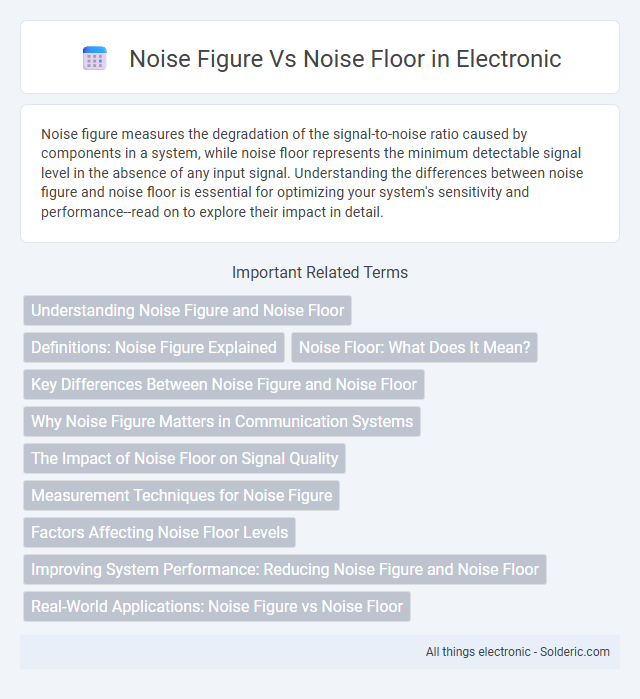Noise figure measures the degradation of the signal-to-noise ratio caused by components in a system, while noise floor represents the minimum detectable signal level in the absence of any input signal. Understanding the differences between noise figure and noise floor is essential for optimizing your system's sensitivity and performance--read on to explore their impact in detail.
Comparison Table
| Parameter | Noise Figure | Noise Floor |
|---|---|---|
| Definition | Measure of degradation of signal-to-noise ratio (SNR) caused by components in a signal chain. | The minimum detectable noise level by a receiver, typically in dBm or dBW. |
| Unit | Decibels (dB) | Decibels referenced to 1 milliwatt (dBm) or watts (dBW) |
| Purpose | Quantifies noise added by an active device or system. | Indicates baseline noise level for system sensitivity. |
| Typical Range | 1 dB to 10 dB for low-noise amplifiers | Varies based on bandwidth and system, e.g. -174 dBm/Hz thermal noise floor at room temp |
| Dependency | Depends on device characteristics and operating frequency. | Depends on temperature, bandwidth, and receiver characteristics. |
| Impact on System | Higher noise figure reduces overall system sensitivity and increases noise. | Higher noise floor reduces the ability to detect weak signals. |
Understanding Noise Figure and Noise Floor
Noise figure quantifies the degradation of the signal-to-noise ratio caused by components in a communication system, reflecting the added noise relative to an ideal device. Noise floor represents the minimum detectable signal level due to the background noise present in the system or environment. Understanding the relationship between noise figure and noise floor is crucial for optimizing receiver sensitivity and ensuring accurate signal detection.
Definitions: Noise Figure Explained
Noise figure quantifies the degradation of the signal-to-noise ratio (SNR) caused by a device or system, representing how much noise the component adds relative to an ideal noiseless device. Noise floor refers to the inherent background noise level present in a system or environment, establishing the minimum detectable signal threshold. Understanding noise figure is crucial for designing sensitive receivers as it directly impacts the overall system noise performance above the ambient noise floor.
Noise Floor: What Does It Mean?
Noise floor refers to the minimum level of background noise present in an electronic system or environment, setting the baseline below which signals cannot be distinguished. It is influenced by thermal noise, interference, and device imperfections, and directly impacts the sensitivity of receivers and measurement accuracy. Understanding and minimizing the noise floor is crucial for optimizing signal detection and improving overall system performance.
Key Differences Between Noise Figure and Noise Floor
Noise figure quantifies the degradation of the signal-to-noise ratio caused by components in a system, expressed in decibels (dB), while noise floor represents the minimum detectable signal level influenced by intrinsic system noise. Noise figure is a parameter to evaluate the quality and performance of amplifiers and receivers, whereas noise floor defines the baseline noise level of the entire measurement or communication environment. Understanding your system's noise figure helps optimize sensitivity, whereas knowing the noise floor guides the detection limits of weak signals.
Why Noise Figure Matters in Communication Systems
Noise figure quantifies the degradation of the signal-to-noise ratio (SNR) introduced by a communication device, directly impacting overall system sensitivity and performance. A lower noise figure indicates better preservation of the input signal quality, essential for accurate signal detection and enhancing receiver sensitivity in wireless communication systems. Noise floor represents the baseline environmental noise level but controlling the noise figure is critical to minimize added noise and optimize the effective dynamic range of RF receivers.
The Impact of Noise Floor on Signal Quality
The noise floor sets the baseline level of background noise in a system, directly impacting the minimum detectable signal strength and overall signal quality. A high noise floor can mask weak signals, reducing the effective dynamic range and increasing bit error rates in communication systems. Understanding and minimizing the noise floor is crucial for optimizing sensitivity and ensuring reliable data transmission in RF and audio applications.
Measurement Techniques for Noise Figure
Accurate measurement of noise figure relies on techniques such as the Y-factor method, which uses a calibrated noise source to determine the ratio of output noise power with hot and cold states. The cold-source method involves measuring output noise with a cold input termination, simplifying calculations but requiring precise equipment. Your choice of technique impacts measurement accuracy and must consider factors like bandwidth, temperature stability, and calibration traceability to ensure reliable noise figure evaluations.
Factors Affecting Noise Floor Levels
Noise floor levels are primarily influenced by thermal noise, ambient electromagnetic interference, and the quality of the receiver's front-end components. Factors such as bandwidth, temperature, and shielding effectiveness directly impact the minimum detectable signal threshold. Understanding these elements is crucial for optimizing system sensitivity and minimizing noise figure degradation in communication receivers.
Improving System Performance: Reducing Noise Figure and Noise Floor
Reducing the noise figure of your system minimizes the additional noise introduced by components, directly enhancing signal clarity and overall performance. Lowering the noise floor improves the system's ability to detect weak signals by decreasing the background noise level, which is crucial in sensitive applications such as RF communication and radar systems. Optimizing both noise figure and noise floor together leads to a significant boost in dynamic range and signal-to-noise ratio, ensuring more reliable and accurate system operation.
Real-World Applications: Noise Figure vs Noise Floor
Noise figure quantifies the degradation of signal-to-noise ratio by a device, while noise floor represents the baseline noise power level in a system. In real-world applications like wireless communication and radar, minimizing noise figure improves receiver sensitivity, enabling detection of weak signals above the noise floor. Understanding the relationship between noise figure and noise floor helps you optimize system performance for clearer signal reception and enhanced overall reliability.
Noise figure vs Noise floor Infographic

 solderic.com
solderic.com